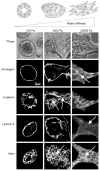Demystifying the effects of a three-dimensional microenvironment in tissue morphogenesis
- PMID: 17613324
- PMCID: PMC2658721
- DOI: 10.1016/S0091-679X(07)83023-8
Demystifying the effects of a three-dimensional microenvironment in tissue morphogenesis
Abstract
Tissue morphogenesis and homeostasis are dependent on a complex dialogue between multiple cell types and chemical and physical cues in the surrounding microenvironment. The emergence of engineered three-dimensional (3D) tissue constructs and the development of tractable methods to recapitulate the native tissue microenvironment ex vivo has led to a deeper understanding of tissue-specific behavior. However, much remains unclear about how the microenvironment and aberrations therein directly affect tissue morphogenesis and behavior. Elucidating the role of the microenvironment in directing tissue-specific behavior will aid in the development of surrogate tissues and tractable approaches to diagnose and treat chronic-debilitating diseases such as cancer and atherosclerosis. Toward this goal, 3D organotypic models have been developed to clarify the mechanisms of epithelial morphogenesis and the subsequent maintenance of tissue homeostasis. Here we describe the application of these 3D culture models to illustrate how the microenvironment plays a critical role in regulating mammary tissue function and signaling, and discuss the rationale for applying precisely defined organotypic culture assays to study epithelial cell behavior. Experimental methods are provided to generate and manipulate 3D organotypic cultures to study the effect of matrix stiffness and matrix dimensionality on epithelial tissue morphology and signaling. We end by discussing technical limitations of currently available systems and by presenting opportunities for improvement.
Figures


Similar articles
-
A 3D Fibroblast-Epithelium Co-culture Model for Understanding Microenvironmental Role in Branching Morphogenesis of the Mammary Gland.Methods Mol Biol. 2017;1501:217-231. doi: 10.1007/978-1-4939-6475-8_10. Methods Mol Biol. 2017. PMID: 27796955
-
3D culture assays of murine mammary branching morphogenesis and epithelial invasion.Methods Mol Biol. 2015;1189:135-62. doi: 10.1007/978-1-4939-1164-6_10. Methods Mol Biol. 2015. PMID: 25245692 Free PMC article.
-
Isolation of mammary epithelial cells from three-dimensional mixed-cell spheroid co-culture.J Vis Exp. 2012 Apr 30;(62):3760. doi: 10.3791/3760. J Vis Exp. 2012. PMID: 22566026 Free PMC article.
-
Comparative mechanisms of branching morphogenesis in diverse systems.J Mammary Gland Biol Neoplasia. 2006 Oct;11(3-4):213-28. doi: 10.1007/s10911-006-9027-z. J Mammary Gland Biol Neoplasia. 2006. PMID: 17120154 Free PMC article. Review.
-
Inductive signals in branching morphogenesis - lessons from mammary and salivary glands.Curr Opin Cell Biol. 2019 Dec;61:72-78. doi: 10.1016/j.ceb.2019.07.001. Epub 2019 Aug 3. Curr Opin Cell Biol. 2019. PMID: 31387017 Review.
Cited by
-
The effect of substrate modulus on the growth and function of matrix-embedded endothelial cells.Biomaterials. 2013 Jan;34(3):677-84. doi: 10.1016/j.biomaterials.2012.09.079. Epub 2012 Oct 24. Biomaterials. 2013. PMID: 23102623 Free PMC article.
-
Regulation of adipose oestrogen output by mechanical stress.Nat Commun. 2013;4:1821. doi: 10.1038/ncomms2794. Nat Commun. 2013. PMID: 23652009 Free PMC article.
-
Probing biological nanotopology via diffusion of weakly constrained plasmonic nanorods with optical coherence tomography.Proc Natl Acad Sci U S A. 2014 Oct 14;111(41):E4289-97. doi: 10.1073/pnas.1409321111. Epub 2014 Sep 29. Proc Natl Acad Sci U S A. 2014. PMID: 25267619 Free PMC article.
-
Mechanics, malignancy, and metastasis: the force journey of a tumor cell.Cancer Metastasis Rev. 2009 Jun;28(1-2):113-27. doi: 10.1007/s10555-008-9173-4. Cancer Metastasis Rev. 2009. PMID: 19153673 Free PMC article. Review.
-
Longitudinal study of mammary epithelial and fibroblast co-cultures using optical coherence tomography reveals morphological hallmarks of pre-malignancy.PLoS One. 2012;7(11):e49148. doi: 10.1371/journal.pone.0049148. Epub 2012 Nov 12. PLoS One. 2012. PMID: 23152864 Free PMC article.
References
-
- Alford D, Baeckstrom D, Geyp M, Pitha P, Taylor-Papadimitriou J. Integrin-matrix interactions affect the form of the structures developing from human mammary epithelial cells in collagen or fibrin gels. J Cell Sci. 1998;111(Pt 4):521–532. - PubMed
-
- Azuma M, Sato M. Morphogenesis of normal human salivary gland cells in vitro. Histol Histopathol. 1994;4:781–790. - PubMed
Publication types
MeSH terms
Substances
Grants and funding
LinkOut - more resources
Full Text Sources
Other Literature Sources

